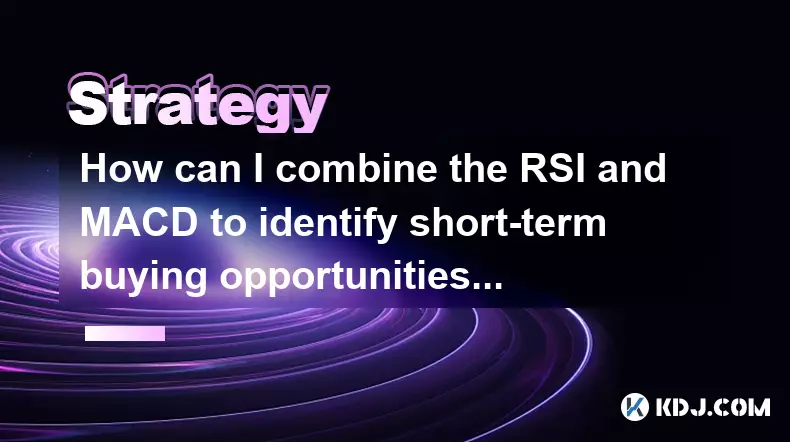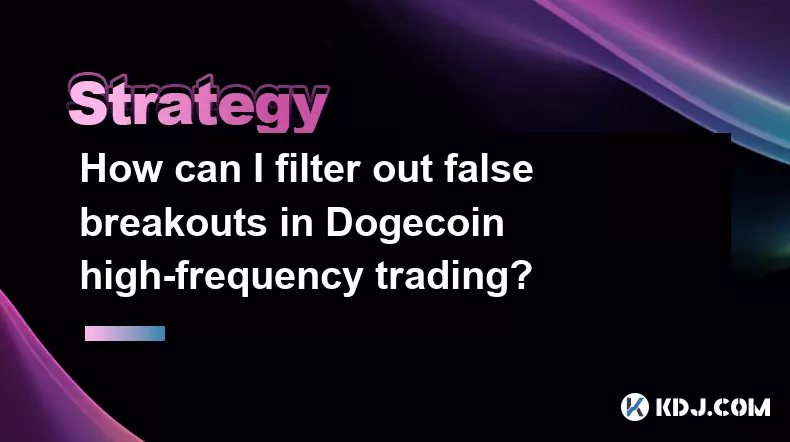-
 bitcoin
bitcoin $109523.663807 USD
-0.13% -
 ethereum
ethereum $4019.526508 USD
2.06% -
 tether
tether $1.000482 USD
0.00% -
 xrp
xrp $2.776815 USD
0.18% -
 bnb
bnb $958.942396 USD
0.12% -
 solana
solana $204.294698 USD
3.84% -
 usd-coin
usd-coin $0.999693 USD
0.00% -
 dogecoin
dogecoin $0.232115 USD
2.09% -
 tron
tron $0.338028 USD
0.84% -
 cardano
cardano $0.790920 USD
1.50% -
 hyperliquid
hyperliquid $44.871443 USD
5.60% -
 ethena-usde
ethena-usde $1.000322 USD
0.04% -
 chainlink
chainlink $21.034165 USD
2.60% -
 avalanche
avalanche $28.794831 USD
-0.54% -
 stellar
stellar $0.360466 USD
1.24%
How can I combine the RSI and MACD to identify short-term buying opportunities in Bitcoincoin?
A strong Dogecoin buy signal forms when RSI rises above 30 and MACD crosses bullish, especially with rising volume and positive market trends.
Sep 20, 2025 at 10:54 pm

Understanding RSI and MACD in the Context of Dogecoin
1. The Relative Strength Index (RSI) measures the speed and change of price movements on a scale from 0 to 100, helping traders identify overbought or oversold conditions. When applied to Dogecoin, an asset known for high volatility, RSI values below 30 typically suggest the coin is oversold and could be due for a bounce.
2. The Moving Average Convergence Divergence (MACD) tracks the relationship between two exponential moving averages and provides signals through crossovers, divergences, and histogram shifts. For Dogecoin, which often experiences rapid directional moves, the MACD can confirm momentum shifts when its signal line crosses the MACD line.
3. Combining both indicators allows traders to filter false signals. For instance, a low RSI might suggest a buying opportunity, but without bullish momentum confirmed by MACD, the reversal may not materialize. Using them together increases the probability of identifying valid short-term entries.
4. Timeframe selection is crucial. Traders focusing on short-term opportunities in Dogecoin often use 15-minute or 1-hour charts. These intervals provide enough data points for reliable signals while remaining responsive to sudden market sentiment changes common in meme coins.
5. It's important to remember that both RSI and MACD are lagging indicators. While they help interpret past price action, they do not predict future movements with certainty. Their effectiveness improves when aligned with broader market trends or news-driven catalysts affecting Dogecoin’s price.
Signal Alignment for Entry Points
1. A potential buy signal emerges when the RSI drops below 30, indicating oversold conditions, and then begins to rise back above this level. This suggests downward momentum is weakening and buyers may be stepping in.
2. Simultaneously, watch for the MACD line (the difference between the 12-period and 26-period EMAs) to cross above the signal line (9-period EMA of the MACD line). This bullish crossover confirms increasing upward momentum.
3. The convergence of these two events—RSI exiting oversold territory and a bullish MACD crossover—forms a stronger case for a short-term long position in Dogecoin.
4. Additional confirmation can come from the MACD histogram turning positive after being negative, showing that bearish pressure is diminishing and bullish energy is building.
5. Volume should also be considered. A spike in trading volume during the RSI and MACD alignment increases confidence that institutional or coordinated retail buying is occurring, reinforcing the validity of the entry signal.
Managing Risk and Position Size
1. Even with strong technical confluence, Dogecoin’s price can reverse quickly due to social media trends or whale activity. Placing a stop-loss just below the recent swing low helps limit downside exposure.
2. Position sizing should reflect the speculative nature of meme coins. Allocating a smaller percentage of capital per trade ensures that a single adverse move does not significantly impact the overall portfolio.
3. Take-profit levels can be set using recent resistance zones or Fibonacci extensions. Trailing stops are also effective in capturing extended moves if Dogecoin enters a pump phase.
4. Avoid holding positions over weekends or major event periods unless actively monitoring the market. Dogecoin is particularly sensitive to tweets, announcements, or exchange listings that can trigger sharp gaps.
5. Never rely solely on RSI and MACD without considering the broader market structure. If Bitcoin is in a downtrend, even strong Dogecoin-specific signals may fail due to correlated crypto market behavior.
Frequently Asked Questions
What RSI and MACD settings work best for Dogecoin on a 1-hour chart?A standard 14-period RSI and MACD (12,26,9) are widely used and effective. Some traders adjust the RSI to 10 periods for increased sensitivity to quick moves, especially during low-liquidity periods.
Can RSI and MACD give false signals in sideways Dogecoin markets?Yes. In ranging conditions, RSI may repeatedly hit oversold or overbought levels without sustained follow-through. MACD can produce whipsaws when the price oscillates without clear direction. Use Bollinger Bands or support/resistance levels to determine if the market is range-bound.
How do I know if a MACD crossover is strong enough to act on?Look at the distance of the MACD lines from the zero centerline. A crossover occurring deep in negative territory after a prolonged drop carries more weight than one near zero. Also, a rapidly expanding histogram adds conviction to the signal.
Should I use leverage when entering based on RSI and MACD signals?Leverage amplifies both gains and losses. Given Dogecoin’s unpredictability, using high leverage on RSI-MACD signals can lead to liquidation even if the overall prediction is correct. Conservative or no leverage is advisable for sustainable trading.
Disclaimer:info@kdj.com
The information provided is not trading advice. kdj.com does not assume any responsibility for any investments made based on the information provided in this article. Cryptocurrencies are highly volatile and it is highly recommended that you invest with caution after thorough research!
If you believe that the content used on this website infringes your copyright, please contact us immediately (info@kdj.com) and we will delete it promptly.
- Token Costs, AI Scaling, and Computing Power: The Quest for Efficiency
- 2025-09-27 14:25:15
- Qwen3Guard: A Leap Towards Multilingual AI Safety
- 2025-09-27 14:25:15
- Rare 1p Coin Could Fetch £200,000: Are You Holding a Fortune?
- 2025-09-27 12:25:13
- MAGACOIN Finance: Buzz, Risks, and the Altcoin Stampede
- 2025-09-27 12:25:13
- Crypto Wallets & Utility Tokens: What's the Hype?
- 2025-09-27 12:30:02
- Coin Memes, Pumpfun, and ChatGPT: Navigating the Wild West of Crypto
- 2025-09-27 14:30:01
Related knowledge

Practical parameter settings for a Bitcoin multi-timeframe moving average system
Sep 18,2025 at 10:54pm
Optimizing Timeframe Combinations for Bitcoin Trading1. Selecting appropriate timeframes is crucial when building a multi-timeframe moving average sys...

How can I filter out false breakouts in Dogecoin high-frequency trading?
Sep 22,2025 at 01:00am
Understanding False Breakouts in Dogecoin Trading1. A false breakout occurs when Dogecoin's price appears to move beyond a defined support or resistan...

Techniques for identifying tops and bottoms in the Bitcoin on-chain NVT model
Sep 20,2025 at 07:54pm
Understanding the NVT Model in Bitcoin Analysis1. The Network Value to Transactions (NVT) ratio is often described as the 'P/E ratio' of the cryptocur...

What does the surge in open interest in Bitcoincoin futures mean?
Sep 20,2025 at 11:18pm
Understanding the Surge in Dogecoin Futures Open Interest1. A surge in open interest within Dogecoin futures indicates a growing number of active cont...

How can I use the Ethereum USDT premium to gauge market sentiment?
Sep 18,2025 at 11:55pm
Understanding the Ethereum USDT Premium1. The Ethereum USDT premium refers to the price difference between USDT (Tether) traded on Ethereum-based plat...

What should I do if Ethereum staking yields decline?
Sep 20,2025 at 06:18am
Understanding the Causes Behind Declining Ethereum Staking Yields1. The Ethereum network transitioned to a proof-of-stake consensus mechanism with the...

Practical parameter settings for a Bitcoin multi-timeframe moving average system
Sep 18,2025 at 10:54pm
Optimizing Timeframe Combinations for Bitcoin Trading1. Selecting appropriate timeframes is crucial when building a multi-timeframe moving average sys...

How can I filter out false breakouts in Dogecoin high-frequency trading?
Sep 22,2025 at 01:00am
Understanding False Breakouts in Dogecoin Trading1. A false breakout occurs when Dogecoin's price appears to move beyond a defined support or resistan...

Techniques for identifying tops and bottoms in the Bitcoin on-chain NVT model
Sep 20,2025 at 07:54pm
Understanding the NVT Model in Bitcoin Analysis1. The Network Value to Transactions (NVT) ratio is often described as the 'P/E ratio' of the cryptocur...

What does the surge in open interest in Bitcoincoin futures mean?
Sep 20,2025 at 11:18pm
Understanding the Surge in Dogecoin Futures Open Interest1. A surge in open interest within Dogecoin futures indicates a growing number of active cont...

How can I use the Ethereum USDT premium to gauge market sentiment?
Sep 18,2025 at 11:55pm
Understanding the Ethereum USDT Premium1. The Ethereum USDT premium refers to the price difference between USDT (Tether) traded on Ethereum-based plat...

What should I do if Ethereum staking yields decline?
Sep 20,2025 at 06:18am
Understanding the Causes Behind Declining Ethereum Staking Yields1. The Ethereum network transitioned to a proof-of-stake consensus mechanism with the...
See all articles










































































